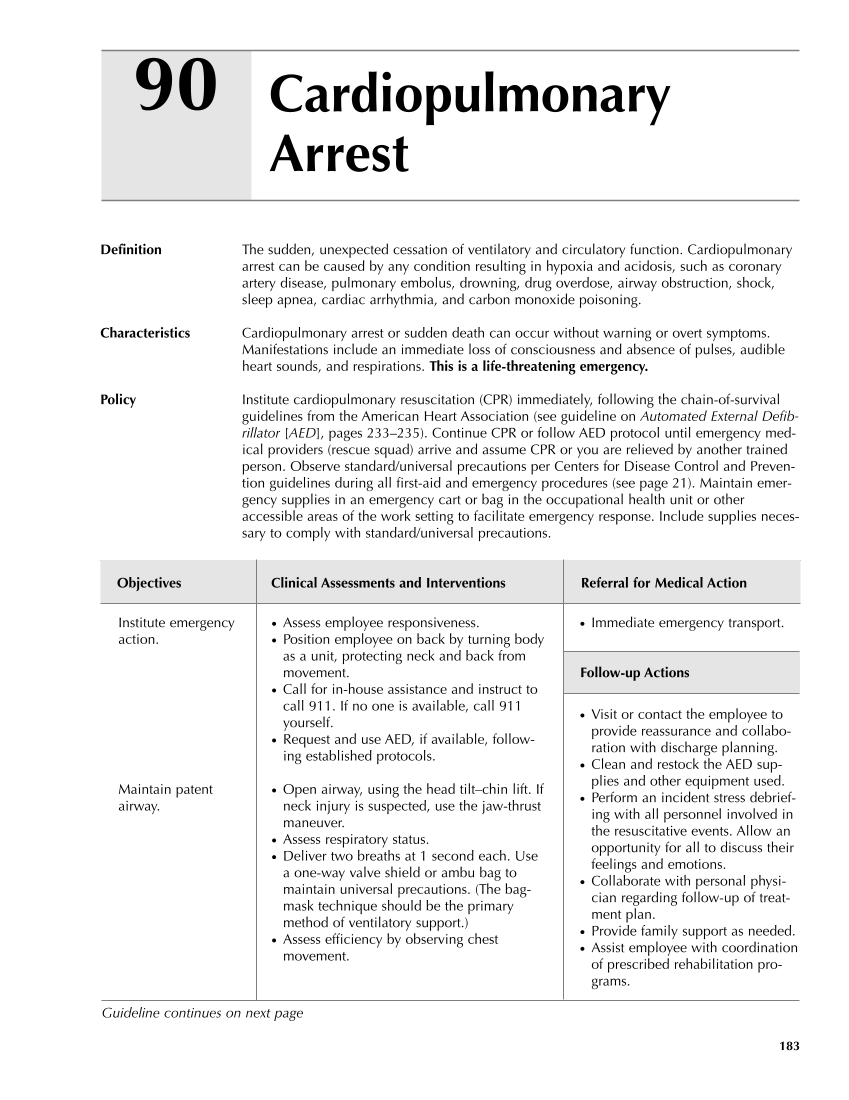183 Cardiopulmonary Arrest 90 Definition The sudden, unexpected cessation of ventilatory and circulatory function. Cardiopulmonary arrest can be caused by any condition resulting in hypoxia and acidosis, such as coronary artery disease, pulmonary embolus, drowning, drug overdose, airway obstruction, shock, sleep apnea, cardiac arrhythmia, and carbon monoxide poisoning. Characteristics Cardiopulmonary arrest or sudden death can occur without warning or overt symptoms. Manifestations include an immediate loss of consciousness and absence of pulses, audible heart sounds, and respirations. This is a life-threatening emergency. Policy Institute cardiopulmonary resuscitation (CPR) immediately, following the chain-of-survival guidelines from the American Heart Association (see guideline on Automated External Defib- rillator [AED], pages 233–235). Continue CPR or follow AED protocol until emergency med- ical providers (rescue squad) arrive and assume CPR or you are relieved by another trained person. Observe standard/universal precautions per Centers for Disease Control and Preven- tion guidelines during all first-aid and emergency procedures (see page 21). Maintain emer- gency supplies in an emergency cart or bag in the occupational health unit or other accessible areas of the work setting to facilitate emergency response. Include supplies neces- sary to comply with standard/universal precautions. Objectives Clinical Assessments and Interventions Referral for Medical Action ● Immediate emergency transport. Follow-up Actions ● Visit or contact the employee to provide reassurance and collabo- ration with discharge planning. ● Clean and restock the AED sup- plies and other equipment used. ● Perform an incident stress debrief- ing with all personnel involved in the resuscitative events. Allow an opportunity for all to discuss their feelings and emotions. ● Collaborate with personal physi- cian regarding follow-up of treat- ment plan. ● Provide family support as needed. ● Assist employee with coordination of prescribed rehabilitation pro- grams. Institute emergency action. Maintain patent airway. ● Assess employee responsiveness. ● Position employee on back by turning body as a unit, protecting neck and back from movement. ● Call for in-house assistance and instruct to call 911. If no one is available, call 911 yourself. ● Request and use AED, if available, follow- ing established protocols. ● Open airway, using the head tilt–chin lift. If neck injury is suspected, use the jaw-thrust maneuver. ● Assess respiratory status. ● Deliver two breaths at 1 second each. Use a one-way valve shield or ambu bag to maintain universal precautions. (The bag- mask technique should be the primary method of ventilatory support.) ● Assess efficiency by observing chest movement. Guideline continues on next page
Purchased from OEM Press by (ge corporate access). (C) 2013 OEM Health Information, Inc. All rights reserved.












































































































































































































































































































































































































































